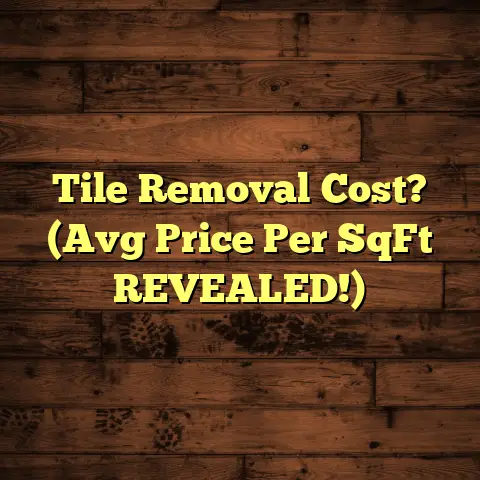Water Under Laminate: Dry It Now! (2 Fixes Needed!)
It was a Tuesday, I remember it vividly. I was heading down to my basement, ready to tackle a little weekend project, when I felt it.
Squish.
Not just any squish, but that dreaded “something’s-not-right” squish. My heart sank faster than a lead balloon. I knew, before I even saw it, that something was terribly wrong.
And there it was. A good portion of my laminate flooring, usually smooth and sturdy, was now wavy and… well, damp. The smell hit me next – that unmistakable musty odor that screams “water damage!” I felt a knot form in my stomach, a potent cocktail of frustration, anxiety, and the looming dollar signs flashing before my eyes.
My first thought? “How the heck did this happen?!” Followed closely by, “Oh no, how much is this going to cost me?” I immediately started tracing the source, fearing the worst – a burst pipe, a leaky foundation, you name it.
Turns out, it was a slightly clogged downspout that had caused rainwater to back up and seep in through a window well. A relatively minor issue, but the damage it caused to my laminate was anything but minor.
I spent the next few days battling the water, ripping up flooring, and frantically trying to dry everything out before mold decided to throw a party. It was a stressful, messy, and honestly, pretty awful experience.
But you know what? I learned a TON. And I’m here to share that knowledge with you, so you can hopefully avoid the same headache I went through.
In this article, we’re diving deep into the world of water-damaged laminate flooring. We’ll cover everything from understanding how water gets trapped in the first place, to immediate actions you need to take, and of course, the two crucial fixes you need to know: repairing the damage and preventing future problems.
So, grab a cup of coffee (or maybe something stronger!), and let’s get started.
Section 1: Understanding the Problem
Okay, so you’ve found water under your laminate. First off, take a deep breath. It’s not the end of the world, although it might feel like it right now. But before you start tearing things up, let’s understand why this happened.
How Does Water Get Trapped?
Laminate flooring, while beautiful and relatively durable, isn’t waterproof. It’s water-resistant, which means it can handle small spills if you clean them up quickly. But prolonged exposure to moisture? Big trouble.
Here are some common culprits:
-
Leaks: This is the most obvious one. A leaky pipe, a dripping faucet, a running toilet – any of these can lead to water seeping under your laminate. I once had a client whose refrigerator water line had a pinhole leak that went undetected for weeks!
-
Flooding: Whether it’s a major weather event or a smaller incident like a washing machine overflow, flooding can quickly saturate your flooring. Basements are especially vulnerable.
-
Condensation: In humid climates or areas with poor ventilation, condensation can build up under laminate, especially if it’s installed over a concrete slab. Think bathrooms, laundry rooms, and poorly insulated basements.
-
Spills: Okay, we all spill things. But if you’re constantly mopping up spills and not drying the area thoroughly, water can eventually seep into the seams of your laminate.
-
Improper Installation: This is a big one! If your laminate wasn’t installed correctly, especially if a proper moisture barrier wasn’t used, you’re basically inviting water problems.
Laminate vs. Other Flooring Types
Laminate flooring is constructed in layers, typically consisting of:
- Wear Layer: A clear, protective top layer.
- Decorative Layer: A printed image that mimics wood, stone, or other materials.
- Core Board: Usually made of high-density fiberboard (HDF) or medium-density fiberboard (MDF). This is the problem area!
- Backing Layer: A bottom layer that provides stability and moisture resistance (to a degree).
Unlike solid hardwood, which can expand and contract with moisture changes, laminate’s core board is highly susceptible to water damage. When it gets wet, it can swell, warp, and even delaminate (separate into layers).
Think of it like a sponge – it soaks up water and doesn’t let go easily.
The Alarming Statistics
Don’t just take my word for it. Water damage is a HUGE problem for homeowners.
-
According to the EPA, household leaks can waste nearly 1 trillion gallons of water annually nationwide. That’s a lot of potential for flooring damage!
-
The Insurance Information Institute reports that water damage is one of the most frequent and costly homeowners insurance claims.
-
A study by the National Association of Home Builders found that moisture-related problems are a leading cause of construction defects and homeowner complaints.
“Moisture intrusion is the silent enemy of buildings. It can lead to a cascade of problems, from structural damage to health issues.” – Joseph Lstiburek, Building Science Corporation
These statistics aren’t meant to scare you, but to highlight the importance of taking water damage seriously.
The Long-Term Effects
So, what happens if you ignore water under your laminate? Here’s a glimpse into the potential nightmare:
-
Mold Growth: This is the biggest concern. Mold thrives in damp, dark environments, and it can start growing within 24-48 hours of water exposure. Mold can cause a range of health problems, from allergies and asthma to more serious respiratory issues.
-
Structural Damage: Over time, water can weaken the subfloor beneath your laminate, leading to soft spots, rot, and even structural instability.
-
Unpleasant Odors: That musty smell we talked about earlier? It’s not just unpleasant, it’s a sign that mold and mildew are present.
-
Reduced Home Value: Water damage can significantly decrease the value of your home. Nobody wants to buy a house with mold problems or structural issues.
-
Health Risks: As mentioned earlier, mold exposure can be harmful to your health, especially for children, the elderly, and people with compromised immune systems.
Okay, enough doom and gloom. Let’s move on to the good stuff – what you can actually do about it.
Section 2: Immediate Actions to Take
Alright, you’ve discovered water under your laminate. Time is of the essence! Here’s what you need to do ASAP:
Step 1: Stop the Source!
This is priority number one. Find the source of the water and stop it immediately. Turn off the water supply if it’s a burst pipe. Unclog that downspout. Fix that leaky faucet. You get the idea.
Step 2: Assess the Damage
Take a good look at the affected area. How far does the water damage extend? Are there any signs of warping, discoloration, or mold growth? Use a flashlight to get a better view.
Pay close attention to the seams between the laminate planks. This is where water tends to seep in first. Sniff around for that musty odor.
Step 3: Remove Furniture and Belongings
Get everything out of the affected area. Furniture, rugs, boxes – anything that can absorb water or block airflow. This will help the area dry out faster and prevent further damage.
If your furniture is wet, try to dry it out as quickly as possible to prevent mold growth. You can use fans, dehumidifiers, or even take it outside in the sun (if the weather permits).
Step 4: Dry It Out!
This is where the real work begins. Your goal is to remove as much water as possible and dry out the area as quickly as you can.
Here are some methods you can use:
-
Towels: Use absorbent towels to soak up standing water. Wring them out frequently and replace them with dry towels.
-
Fans: Place fans around the perimeter of the affected area to circulate air and promote evaporation. Aim the fans towards the wet flooring.
-
Dehumidifiers: These are your best friend! Dehumidifiers remove moisture from the air, which helps to dry out the flooring and prevent mold growth. Run them continuously until the area is completely dry.
-
Wet/Dry Vacuum: A wet/dry vacuum can be used to suck up standing water from the surface of the laminate.
-
Remove Baseboards: Carefully remove the baseboards around the perimeter of the room. This will allow air to circulate under the laminate and help it dry out faster. Be careful not to damage the baseboards when removing them.
I usually recommend running fans and dehumidifiers for at least 48-72 hours, or until the flooring feels completely dry to the touch.
Step 5: Check for Underlying Issues
Once you’ve dried out the area, it’s time to investigate the cause of the water damage. Check for leaks in pipes, around windows, and in the foundation. Look for signs of condensation or poor ventilation.
If you suspect a plumbing leak, call a plumber immediately. Don’t try to fix it yourself unless you’re experienced.
If you find any other issues, address them promptly to prevent future water damage.
Section 3: Fix #1 – Repairing the Damage
Okay, so you’ve stopped the leak, dried everything out, and assessed the damage. Now it’s time to get down to the nitty-gritty and repair or replace the damaged laminate.
Assessing the Damage (Again)
Before you start ripping things up, take another look at the affected area. How many planks are damaged? Is the subfloor wet or damaged? Is there any sign of mold growth?
If the damage is minimal (e.g., a few slightly warped planks), you might be able to get away with replacing just those planks. But if the damage is extensive, you might need to replace the entire floor.
Gathering Your Tools
Here’s a list of tools you’ll need for this project:
- Safety Glasses: Protect your eyes from debris.
- Gloves: Protect your hands from dirt and chemicals.
- Pry Bar: For removing baseboards and planks.
- Hammer: For tapping planks into place.
- Tapping Block: Protects the edges of the planks during installation.
- Pull Bar: Helps to tighten the seams between planks.
- Measuring Tape: For measuring and cutting planks.
- Utility Knife: For scoring and cutting planks.
- Circular Saw or Hand Saw: For cutting planks to size.
- Moisture Meter: To check the moisture content of the subfloor.
- Shop Vacuum: For cleaning up debris.
Step 1: Removing the Damaged Planks
This can be a bit tricky, depending on the type of laminate flooring you have. Some laminate floors have a click-lock system, which makes it relatively easy to remove planks. Others are glued down, which requires a bit more effort.
Here’s a general guide:
-
Remove the Baseboards: Carefully pry off the baseboards around the perimeter of the room. Use a pry bar and be careful not to damage the baseboards or the wall.
-
Identify the First Plank: Start with a plank that’s close to the wall. You might need to remove a few undamaged planks to get to the damaged ones.
-
Pry Up the Plank: Use a pry bar or a flathead screwdriver to gently pry up the plank. If it’s a click-lock system, you might need to wiggle the plank back and forth to disengage the locking mechanism.
-
Continue Removing Planks: Repeat the process until you’ve removed all the damaged planks. Be careful not to damage the surrounding planks.
If your laminate is glued down, you might need to use a heat gun or a solvent to loosen the adhesive. Be very careful when using these tools, and follow the manufacturer’s instructions.
Step 2: Inspecting the Subfloor
Once you’ve removed the damaged planks, take a close look at the subfloor. Is it wet or damaged? Are there any signs of mold growth?
Use a moisture meter to check the moisture content of the subfloor. Ideally, it should be below 12%. If it’s higher than that, you’ll need to dry it out further before installing new laminate.
If the subfloor is damaged, you’ll need to repair it before installing new laminate. This might involve patching holes, leveling uneven spots, or even replacing sections of the subfloor.
Step 3: Installing New Laminate Planks
Now for the fun part! Installing new laminate planks is usually a straightforward process, but it’s important to follow the manufacturer’s instructions carefully.
Here’s a general guide:
-
Acclimate the New Planks: Before you start installing, let the new laminate planks acclimate to the room for at least 48 hours. This will allow them to adjust to the temperature and humidity of the room, which will help to prevent warping or buckling later on.
-
Prepare the Subfloor: Make sure the subfloor is clean, dry, and level. Sweep or vacuum up any debris. If necessary, apply a leveling compound to smooth out any uneven spots.
-
Install a Moisture Barrier: If you didn’t have one before, now’s the time to install a moisture barrier. This will help to protect your laminate from future water damage.
-
Start Installing Planks: Begin installing the new planks along one wall, leaving a small expansion gap (about 1/4 inch) between the planks and the wall. Use shims to maintain the expansion gap.
-
Click or Glue the Planks Together: Depending on the type of laminate you have, you’ll either click the planks together or glue them down. Follow the manufacturer’s instructions carefully.
-
Cut Planks to Fit: When you reach the end of a row, you’ll need to cut the planks to fit. Use a measuring tape, a utility knife, and a circular saw or hand saw to make the cuts.
-
Stagger the Seams: To create a more natural look, stagger the seams between the planks. This means that the end joints of the planks in one row should not line up with the end joints of the planks in the adjacent rows.
-
Install the Last Row: The last row of planks might need to be cut to fit. Use a pull bar to tighten the seams between the last row of planks and the wall.
-
Reinstall the Baseboards: Once you’ve installed all the planks, reinstall the baseboards. Use a nail gun or finishing nails to attach the baseboards to the wall.
Troubleshooting Tips
-
Planks Won’t Click Together: Make sure the planks are properly aligned and that the locking mechanisms are clean and free of debris. You might need to use a tapping block and a hammer to gently tap the planks into place.
-
Gaps Between Planks: Use a pull bar to tighten the seams between the planks. If the gaps are too large, you might need to remove the planks and start over.
-
Planks Buckling: This is usually caused by moisture. Make sure the subfloor is dry and that you’ve installed a moisture barrier.
Section 4: Fix #2 – Preventing Future Water Issues
Alright, you’ve repaired the damage. Now, let’s make sure this doesn’t happen again. Prevention is key!
Moisture Barriers: Your First Line of Defense
A moisture barrier is a thin layer of material that’s installed between the subfloor and the laminate flooring. It helps to prevent moisture from seeping up from the subfloor and damaging the laminate.
There are several types of moisture barriers available:
-
Polyethylene Film: This is a thin plastic film that’s typically used over concrete slabs.
-
Foam Underlayment: This is a thicker foam material that provides cushioning and insulation in addition to moisture protection.
-
Liquid Moisture Barrier: This is a paint-on coating that’s applied to the subfloor.
Choose the right type of moisture barrier for your specific situation. If you’re installing laminate over a concrete slab, a polyethylene film is usually sufficient. But if you’re installing laminate in a basement or other damp environment, a foam underlayment or a liquid moisture barrier might be a better choice.
Proper Installation Techniques
Proper installation is crucial for preventing water damage. Here are some tips:
-
Follow the Manufacturer’s Instructions: This is the most important thing you can do. The manufacturer knows their product best, so follow their instructions carefully.
-
Leave an Expansion Gap: As mentioned earlier, leave a small expansion gap (about 1/4 inch) between the laminate planks and the wall. This will allow the planks to expand and contract with changes in temperature and humidity.
-
Stagger the Seams: Stagger the seams between the planks to create a more natural look and to prevent water from seeping in.
-
Use a Tapping Block and Pull Bar: These tools will help you to tighten the seams between the planks and ensure a proper fit.
Maintaining a Dry Environment
Here are some tips for maintaining a dry environment in your home:
-
Use Dehumidifiers: If you live in a humid climate, use dehumidifiers to remove moisture from the air.
-
Ensure Proper Ventilation: Make sure your home is properly ventilated. Open windows and doors when the weather permits, and use exhaust fans in bathrooms and kitchens.
-
Fix Leaks Promptly: Don’t ignore leaks! Fix them as soon as you notice them.
-
Clean Up Spills Immediately: Wipe up spills immediately to prevent water from seeping into the seams of your laminate.
Routine Inspections
Regular inspections can help you to catch potential water problems before they become major issues. Here’s what to look for:
-
Water Stains: Check for water stains on walls, ceilings, and floors.
-
Musty Odors: Sniff around for musty odors, which can indicate mold growth.
-
Warping or Buckling: Look for warping or buckling in your laminate flooring.
-
Leaks: Check for leaks in pipes, around windows, and in the foundation.
Additional Protective Measures
Here are some additional measures you can take to protect your laminate flooring from water damage:
-
Water-Resistant Laminate: Consider installing water-resistant laminate in areas that are prone to moisture, such as bathrooms and kitchens.
-
Proper Drainage Systems: If you have a basement, make sure you have a proper drainage system to prevent water from seeping in.
-
Sump Pump: A sump pump can help to remove water from your basement and prevent flooding.
Conclusion: Call to Action
Wow, we’ve covered a lot! Let’s recap the key takeaways:
-
Water under laminate is a serious problem that can lead to mold growth, structural damage, and health risks.
-
Immediate action is crucial. Stop the source of the water, dry out the area, and assess the damage.
-
Repair or replace the damaged laminate, and take steps to prevent future water issues.
-
Moisture barriers, proper installation techniques, and routine inspections are essential for protecting your laminate flooring.
Now, I want you to take action! Go inspect your flooring right now. Look for any signs of water damage, and address any issues promptly.
Don’t wait until it’s too late!
I know dealing with water damage can be stressful, but remember, you’re not alone. By taking the right steps, you can protect your home and your health.
And trust me, the peace of mind that comes from knowing how to handle water-related flooring issues is priceless. You got this!
Happy flooring!





